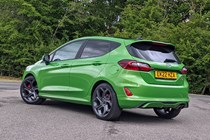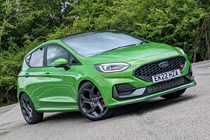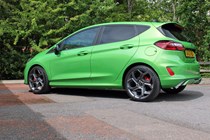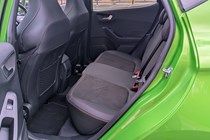Ford Fiesta ST (2022-2023) review
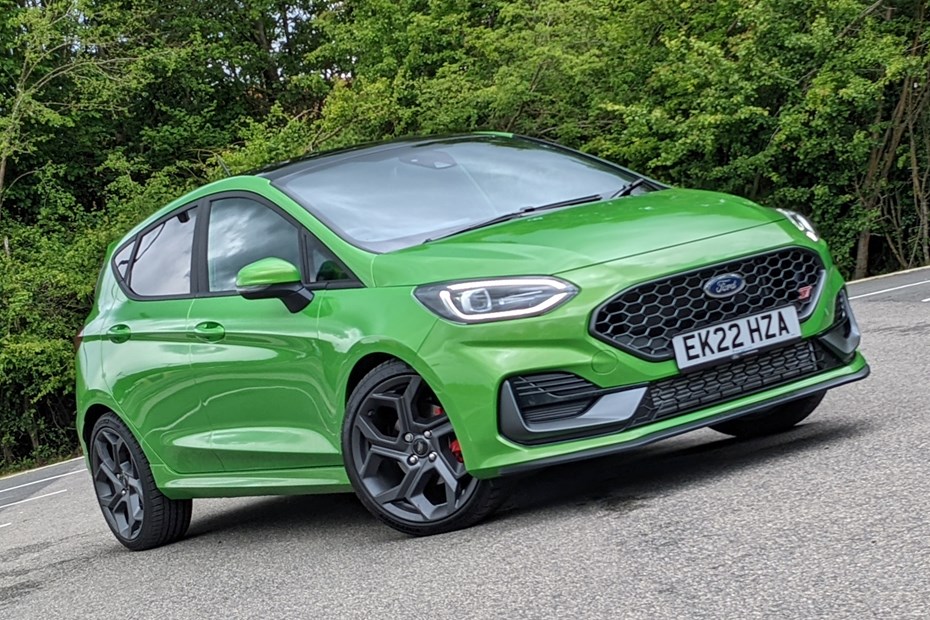
Pros & cons
- Huge fun to drive
- Lots of standard kit
- Plenty of performance
- Firm ride can be uncomfortable
- Some mechanical issues to look out for
- Practicality is limited
Ford Fiesta ST (22-23) rivals
Overview
While the Ford Fiesta is no more, having been discontinued in 2023, it’s fair to say the legend of this little car will live on for years to come – helped in no small part by this Fiesta ST performance variant, one of the very best hot hatches of its generation.
We do not exaggerate when we say this is likely to be a future classic. While there are key rivals, such as the impressive Hyundai i20 N, stylish period Mini Cooper S and well-made VW Polo GTI, the Mk8 Fiesta ST (as it’s known by enthusiasts) is the one that gets our pulses racing.
Powered by a keen, characterful 1.5-litre Ecoboost turbo petrol engine with three cylinders, it goes well – but it’s the sublime chassis tuning that makes it special.
Mk8 Ford Fiesta ST known fault and common problems
On this page we’ll run through every aspect of the last Fiesta ST hot hatch – but our starting point is what to look for if you’re planning to buy one. There are plenty of used Fiesta STs around, the important thing is getting a good one. As such, we’ve listed 10 of the most important areas that you need to check before committing to the deal.
Speaking of deals, a Parkers valuation will help you be sure that you’re getting your money’s worth.
Buying guide
Common issues, and what to look for if you’re thinking of getting one
1. Creaking and knocking noises when steering and/or braking
The Mk8 Fiesta ST is, above all else, supposed to be fun to drive. So make sure the one you’re buying actually is. The car should feel sharp, light on its feet, firmly damped and playful. Listen out for unusual noises when steering and braking – both together and separately – as this can indicate tired components and problems that need solving.
The list of potential cause for such sounds includes (but isn’t limited to) the shock absorbers, the driveshafts, the CV joints, the fitment of the brake pads, and the optional Quaife limited slip differential. The service record and MOT history might help you do a rough diagnosis but some professional exploration will probably be necessary for a definitive cause. Keep your available budget firmly in mind.
2. Rear engine torque mounts
Rear engine mounts, also referred to as torque mounts, are considered a bit of a weak point, leading to axle hop and other issues with the engine not being held quite as closely as it could be when driving hard. There are many, many aftermarket solutions that promise to resolve this perceived weakness, just make sure you’re happy with any refinement issues these fixes may introduce in exchange.
3. Alloy wheels
Take a good look at the alloys. The diamond cut design is prone to corrosion (Ford has even replaced some under warranty) while the combination of firm suspension and the UK’s pothole-scarred roads means bent and buckled wheels aren’t uncommon on these cars. Look out for flat spots around the rim and vibrations when driving, especially when the surface is smooth. An ST that’s taken a hit hard enough to bend a wheel may also need the suspension alignment looking at, so check to see if the steering is straight and test the braking (when safe to do so).
4. Oil consumption
Some Fiesta STs suffered with an oil leak from the cam cover, almost from new. If you’re looking at an older or higher-mileage example it’s worth taking a good look around the whole engine bay with leaks in mind – take a torch. A few owners have reported high oil consumption as well, but before you panic about this it’s best to check the dipstick when the engine is dead cold to get a proper reading. Any sign of blue smoke from the exhaust, though, you should walk away and find a different used ST to buy.
5. Poor gearshift
Can you select every gear easily? Does the gearlever feel vague or loose under your hand? Then the gear selector mechanism may require some attention. Not a deal-breaker, but make sure the purchase price reflects this.
6. Fragile intercooler and air-con condenser
Not just a Ford-specific issue, but nonetheless plenty of ST owners have noticed this one – the intercooler and air-conditioning condenser elements are apparently very easy to bend. Be careful with powerful pressure washers, for instance, as these can potentially cause quite a bit of damage if directed at these components too closely.
7. Exterior quality issues
A few things to check around the outside of the car. Do the door edge protectors – little flap things that pop out when the doors are opened – retract properly or get stuck? Are the headlights in good condition (they can delaminate inside)? Have a close look at the paint, as this wasn’t always very good from the factory and may not be lasting well. Also note that the standard boot-lid gas struts aren’t especially strong; better ones can be purchased aftermarket, and many owners have fitted them.
8. Interior quality issues
On the inside listen for rattling trim – the dashboard and pillar covers are particularly prone to this – and check the condition of the seats. Some had quality problems when new, others aren’t standing the test of time very well. If the steering wheel crunches and/or some of the buttons on it don’t work, it could be the clock spring. Door and window seals can be leaky, so look for watermarks where there shouldn’t be any and check the carpets don’t feel damp.
9. Poor quality modifications
Even if you’re comfortable with buying a modified used car, the quality of the mods is important. Do your homework about brands and question the owner carefully – it should quickly be obvious if they knew what they were doing. Mountune parts, for example, should be okay, as these were available via Ford. But even these can increase wear and tear on important parts reducing the lifespan of the vehicle.
10. Crash damage
The ST is a lively car that makes driving very fast seem easy. In the wrong hands this can quickly result in accident damage that a seller might wish to conceal. Look for mismatched paint and poorly aligned panels – if anything doesn’t seem right, walk away. A car history check is a must for further reassurance.
What models and trims can you buy
Slightly unusually for a hot hatch, the Fiesta ST Mk8 was offered in different levels of specification – launching in ST-1, ST-2 and ST-3 initially, though the number of variants available in the UK was reduced as the car got older. Keen drivers will also want a car with the Performance Pack, which includes the Quaife differential for extra front-end bite.
The ultimate example of this last Fiesta ST, however, was the Performance Edition. Just 300 were made, all finished in orange and fitted with adjustable coilover suspension for greater roadholding.
Ford refreshed the ST in line with the rest of the Ford Fiesta range in September 2021, giving it a new look with the enlarged grille and slightly flattened profile of the so-called Fiesta Mk8.5. You won’t miss the eye-catching new Mean Green finish introduced at the same time, either.
Not all the changes were cosmetic. There was a modest increase in torque (pulling power) as well, and the only spec available was the fully-loaded ST-3, which included the Performance Pack as standard. At this point Ford also discontinued the five-door model.
Keep reading for our detailed review of the Ford Fiesta ST Mk8, taking into account its practicality, comfort, fuel economy and performance. If you’re short on time, you can also skip ahead to our verdict page to see if we recommend the ST as a good used car.
What’s it like inside?
As with modern Fiestas, the ST offers lots of technology in an interior that is nicely put together and reasonably spacious up front for such a small car.
The unavoidable rear doors of later models mean better access to the back seats – and though that doesn’t magically create any more rear legroom or headroom for taller occupants it does make it easier to live with.
Boot space is a relatively modest 311 litres with the rear seats in place, rising to 1,093 litres with them folded. You do have to make do without a spare wheel to even get that much luggage room, though.
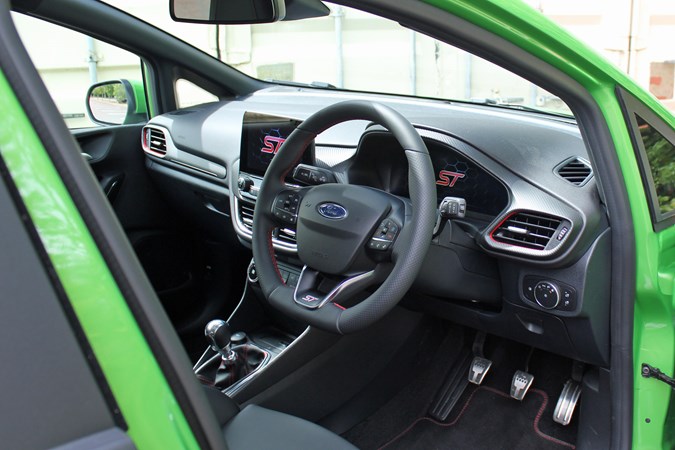
Of more interest to most hot hatch buyers will probably be the useful 8.0-inch touchscreen infotainment system, which combines nicely with the 12.3-inch digital instrument cluster standard on ST-3 spec cars. The animations when you switch between driving modes are perhaps a bit much, but at least you get a sense of occasion whenever you turn the car on.
There’s also a wireless charging pad for your phone, as well as Android Auto and Apple CarPlay, a reversing camera, and active Matrix LED headlights. Ford’s Sync 3 navigation, and the pleasing B&O sound system, are optional.
Sportier Fiesta ST-specific features include a smart flat-bottomed steering wheel, attractive red detailing and some less appealing fake carbonfibre. There are also Ford Performance logos in various places, including on the sill plates and the front seats.
Comfort
The seats are worth a further mention, in fact, as for the facelifted model Ford opted to use its own Ford Performance design across the range in place of the highly sculpted bucket seats fitted to pre-facelift Fiesta ST models.
With multi-way adjustment, the new seats offered almost all the same support but are much wider in the base – making them more comfortable for more people. This does mean that those of slimmer build may find themselves less securely held during the kind of extreme cornering antics the ST is capable of serving up, however.
As small performance cars go, the Fiesta is relatively refined – the engine isn’t overly loud and although there is some wind and road noise, it’s not super tiresome. Or maybe we just didn’t notice because of the ride (more on that in a moment).
Safety
This generation of Ford Fiesta – the Mk8 – received a five-star Euro NCAP crash safety rating in 2017. The Euro NCAP testing regime has got tougher since then., but this should still be a safe car.
The ST is the fastest Fiesta, but it also comes with a lot of standard safety kit, as well as superb dynamics and powerful brakes – which might just get you out of trouble in the first place.
What’s it like to drive?
The Fiesta ST is a firecracker. While there are just three cylinders under the bonnet, the 1.5-litre turbo petrol engine produces an impressive 200hp, and for the facelifted version torque increased from 290Nm to 320Nm. So although 0-62mph in 6.5 seconds isn’t scorchingly quick these days and we’ve become so used to the instant thrust of electric cars, the ST offers plenty of drama – whether you’re accelerating from a standstill or punching down a couple of gears to overtake slower traffic.

But the real genius of the Fiesta ST is just how well it handles corners. When travelling at speed, the suspension does a remarkable job of floating over bad surfaces and absorbing mid-corner bumps, while the balance and poise delivered by the chassis pulls off a superbly blended combo of highly tenacious front-wheel drive traction with a playful rear axle.
This allows you to dart into corners aggressively, then use the throttle to adjust the car’s attitude – all safely within the Fiesta’s healthy limits. Perhaps most fundamentally, it’s just fast enough to be daft without becoming outrageous, and it never feels as if it’s going to catch you out. Rather, it seems to be enjoying itself as much as you are. If you like driving at all, you will love the Fiesta ST when you’re in a hurry.
The downside to all this entertainment is a very firm ride, exacerbated by the larger 18-inch wheels. You don’t notice this so much when you’re indulging yourself, but pootling along at medium speeds it can become a pain in the bottom, verging on actually embarrassing if you have unenthusiastic passengers.
We’d also note the six-speed manual gearbox could be a little sweeter.
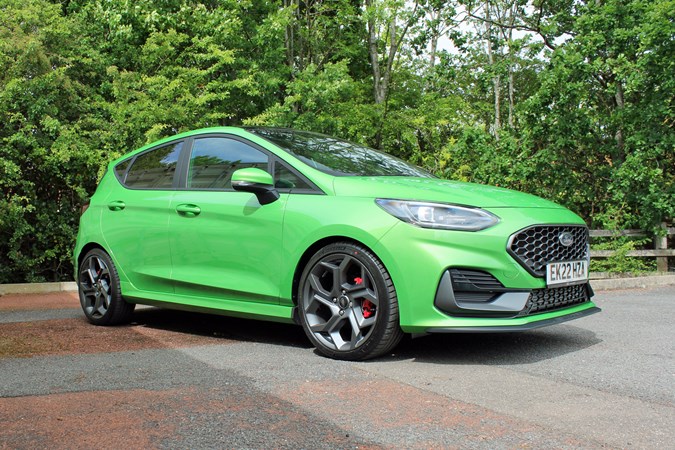
What else should I know?
The Fiesta ST has a couple of tricks tucked up in its… wheelarches.
Beyond the fairly obvious selection of driving modes – with includes a Track setting alongside Normal and Sport instead of the Eco mode you get in regular Fiestas – the Performance Pack adds electronic launch control for the best possible standing starts.
More sensibly, the engine has cylinder deactivation technology, which means it can stop using one combustion chamber when you’re cruising as a means of saving fuel. You’ll near to be pretty saintly to get anywhere near the claimed 41.5mpg, though.
Click through to our long-term test to find out what the Ford Fiesta ST is like to live with, and then read our verdict to find out how we rate this car as a used buy.



